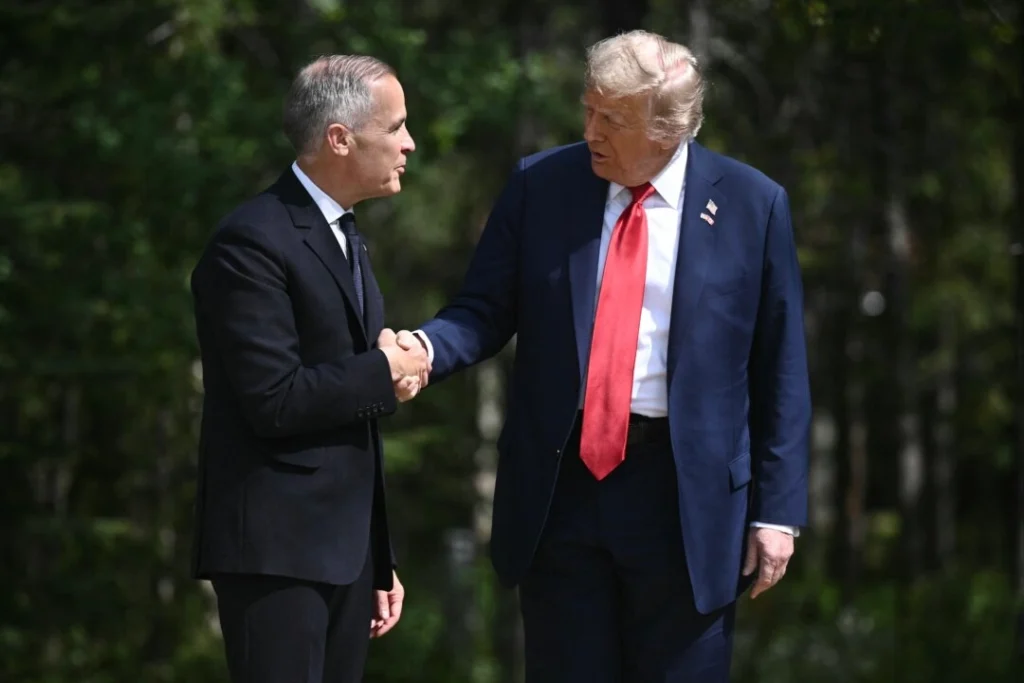
Trump Announces 35 Percent Tariff on Canada, Possible 15–20 Percent Tariffs on Other Countries
President Donald Trump said on July 10 that he would be imposing a blanket 35 percent tariff on Canadian imports.
In a letter posted to his Truth Social Platform, Trump told Canadian Prime Minister Mark Carney that the new tariff rate would take effect on Aug. 1.
“As you will recall, the United States imposed Tariffs on Canada to deal with our Nation’s Fentanyl crisis, which is caused, in part, by Canada’s failure to stop the drugs from pouring into our Country,” Trump wrote.
“Instead of working with the United States, Canada retaliated with its own Tariffs. Starting August 1, 2025, we will charge Canada a Tariff of 35% on Canadian products sent into the United States, separate from all Sectoral Tariffs.”
Carney had earlier said that the two leaders agreed during the G7 summit in Canada on June 16 to reach a new trade deal within 30 days.
On June 27, Trump said he would end all trade talks with Canada unless Ottawa removes its digital services tax (DST), which imposes a 3 percent levy on revenue tech companies such as Amazon receive from Canadian customers. The tax had been a trade irritant for both the Biden and Trump administrations. Canada announced two days later that it would rescind the DST, with Carney adding that the two countries are back on track to reach a new trade deal by July 21.
During the first Trump presidency, Canada had to allow more access to U.S. dairy exporters to secure Washington’s approval for the United States–Mexico–Canada Agreement (USMCA), which replaced NAFTA. Canada’s Parliament recently passed a bill to keep supply management immune from any concessions in future trade negotiations.
Trump’s letter to Carney starts with the president saying it’s a “Great Honor” for him to write to the Canadian prime minister, adding that it “demonstrates the strength and commitment of our Trading Relationship.”
He adds that his country has agreed to “continue working with Canada” despite Ottawa applying counter tariffs on the United States, while warning against any further retaliatory measures by Canada. He also noted that the U.S. tariffs could go down if Canada takes action to stop fentanyl trafficking into the United States.
“If Canada works with me to stop the flow of Fentanyl, we will, perhaps, consider an adjustment to this letter. These Tariffs may be modified, upward or downward, depending on our relationship with your country,” Trump said.Canada applied a series of retaliatory tariffs on American products after U.S. tariffs went into effect earlier this year, but has since dropped some of them.
Carney has called the U.S. tariffs “unjustified,” and said that it is a “top priority” for his government to make a new trade deal with the United States.
Canada’s Industry Minister Mélanie Joly had said hours before Trump’s letter on July 10 that her government would “fight” the U.S. tariffs. Her comments came in reaction to Washington’s newly announced 50 percent tariffs on copper imports.
“Every day we are in a tariff war, and we are defending ourselves,” Joly said.
Tariffs on Canada
Early this year, Trump imposed a 25 percent tariff on both Mexico and Canada, accusing America’s southern and northern trading partners of not doing enough to prevent fentanyl trafficking into the United States.
When Trump announced baseline and reciprocal tariffs on most U.S. trading partners in early April, he said both nations would stay at 25 percent for the time being. Additionally, goods compliant with the USMCA would not be subject to tariffs.
Ottawa has announced a C$1.3 billion plan to boost border security and attempted to show American officials that the flow of fentanyl from Canada into the United States is negligible, but Washington has so far maintained the tariffs it has imposed related to this issue. FBI director Kash Patel has faulted Canada for the flow of fentanyl into his country, saying that hostile regimes like Beijing are collaborating with criminal organizations to smuggle the drug from Canada into the United States.
Trump also levied “sectoral” tariffs on a number of specific products that impact Canada, including steel, lumber, energy, and potash, and new tariffs on copper will be coming effective Aug. 1.
In his letter to Carney, Trump said the blanket 35 percent tariff on Canadian imports would be separate from his sectoral tariffs.
15–20 Percent Tariffs on Other Countries
Trump has sent more than 20 letters to U.S. trading partners this week, informing them of the tariff rates they will see on their exports into the United States if they do not broker trade deals with his administration.
He told NBC’s “Meet the Press” on Thursday that any remaining trading partners that have yet to receive trade letters or negotiate trade agreements with his team will see a blanket tariff rate.
“We’re just going to say all of the remaining countries are going to pay, whether it’s 20% or 15%. We’ll work that out now,” Trump said in a phone interview with moderator Kristen Welker.
This week, Trump also imposed a 50 percent tariff on imports from Brazil, citing an ongoing criminal trial of the nation’s former conservative president, and announced a 50 percent tariff on copper imports that takes effect in August.
Countries have until Aug. 1 to negotiate trade deals with his team or face whatever tariff levels he announces, Trump said.
Correction: A previous version of this article’s headline misspelled President Donald Trump’s name. The Epoch Times regrets the error.


